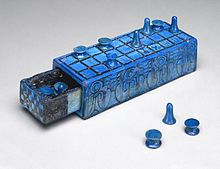Our website is made possible by displaying online advertisements to our visitors.
Please consider supporting us by disabling your ad blocker.
Portal:Games
The Games Portal

A game is a structured type of play, usually undertaken for entertainment or fun, and sometimes used as an educational tool. Many games are also considered to be work (such as professional players of spectator sports or games) or art (such as jigsaw puzzles or games involving an artistic layout such as mahjong, solitaire, or some video games).
Games have a wide range of occasions, reflecting both the generality of its concept and the variety of its play. Games are sometimes played purely for enjoyment, sometimes for achievement or reward as well. They can be played alone, in teams, or online; by amateurs or by professionals. The players may have an audience of non-players, such as when people are entertained by watching a chess championship. On the other hand, players in a game may constitute their own audience as they take their turn to play. Often, part of the entertainment for children playing a game is deciding who is part of their audience and who participates as a player. A toy and a game are not the same. Toys generally allow for unrestricted play, whereas games present rules for the player to follow.
Key components of games are goals, rules, challenge, and interaction. Games generally involve mental or physical stimulation, and often both. Many games help develop practical skills, serve as a form of exercise, or otherwise perform an educational, simulational, or psychological role. (Full article...)
Selected article -
Button Men is a two-player dice game invented by James Ernest of Cheapass Games, first released in 1999.
A game of Button Men typically takes less than ten minutes to play. Each player is represented by a pin-back button or playing card of their choice. The buttons are usually metal or plastic discs, about 2–2.5 inches (5.1–6.4 cm) in diameter, with a pin on the back that can be used to fasten them to clothing. A button bears the name and illustration of the combatant ("Button Man" or "fighter") assumed by the player. Each button indicates the quantity, maximum value, and abilities (if any) of the player's dice. (Full article...)
Did you know? -
- ...that the virtual economy of massively multiplayer online games sometimes attracts virtual crime, which is punishable by real laws in some countries?
- ...that since 1998 All Nippon Airways has operated Pokémon Jets (pictured)?
- ...that the World Chess Hall of Fame originally used cardboard plaques to honor past grandmasters, and was located in the basement of a New Windsor, New York, building?
- ...that the Japanese role-playing game Night Wizard! was adapted into an animated television series consisting of thirteen episodes?
- ...that a 2009 Pennsylvania court case ruled that poker is a game of skill, thus not subject to the state laws related to gambling?
General images
Subcategories
Related portals
WikiProjects
Things to do
Selected picture

Chess prodigy Samuel Reshevsky, aged 8, defeating several chess masters in France
Associated Wikimedia
The following Wikimedia Foundation sister projects provide more on this subject:
-
Commons
Free media repository -
Wikibooks
Free textbooks and manuals -
Wikidata
Free knowledge base -
Wikinews
Free-content news -
Wikiquote
Collection of quotations -
Wikisource
Free-content library -
Wikiversity
Free learning tools -
Wiktionary
Dictionary and thesaurus
Previous Page Next Page





















































